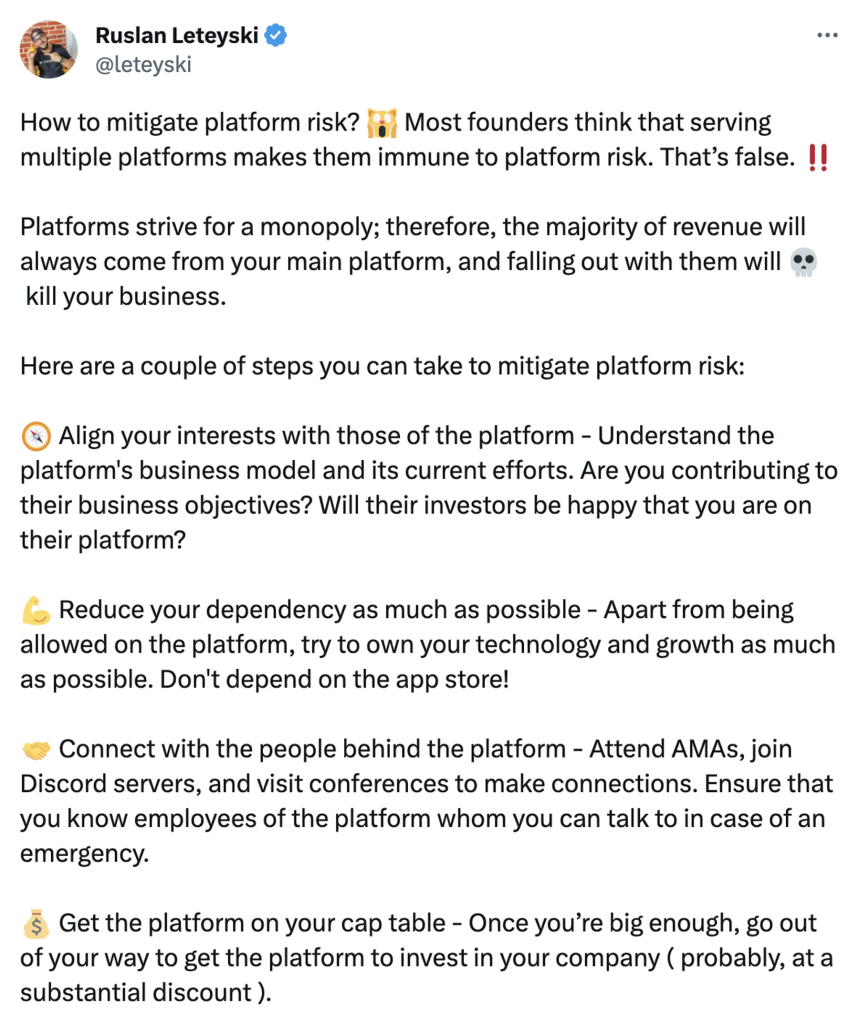Let me first address the unicorn elephant 🐘 in the room.
I don’t know shit 💩 about building unicorn companies.
Never built one. Never invested in one. Never been in business school. So please take what I’m going to write with a bucket of salt.
However, I’ve spent my whole career either working for startups, building startups, and most recently – investing in startups. I’ve achieved some success, I’ve had some failures, and I can tell you this – it doesn’t matter how smart you are or how hard you work if the underlying fundamentals of your business are flawed.
Some businesses are a dead horse, some are instant hits and the rest fall somewhere in between:

So where does that new startup idea / investment opportunity / potential acquisition fall on the scale? I use the Dead Horse framework to try to figure that out.
Some horses ( businesses ) are better than others. The horses that end up growing a horn and pooping 🌈 rainbows share a strong combination of 5 key business fundamentals: Strong need, Favourable market, Scalability, Control, and Defensibility. The ones that don’t – don’t ☹️.
The dead horse framework is no crystal ball 🔮 – it can’t predict the future. Its purpose is to transition your mindset from making a single-dimensional assumption ( Good idea vs Bad idea ) towards a multi-dimensional assumption ( Needed vs Not needed * Scaleable vs Non-scaleable, etc).
1. Strong need 🔥
The simplest and hardest question of every business – why should someone buy your product / hire your services? In order for someone to give you their precious money and attention your business should either:
- Solve a significant problem
- Bring significant value
There are a lot of startup mantras like: “Don’t sell vitamins, sell painkillers”, “Focus on the problem”, etc. It’s not necessary that you solve a particular problem, but you should be aware what is the value that you bring to the customer.

The “problem/solution” question is obvious. What’s not obvious is that you need to consider what are the alternative solutions to the problem you are solving. I’m not talking about your competition, I’m talking about alternatives.
- The competition of a Ford is a Mercedes → the alternative is 🚌 Public Transportation.
- The competition of ChatGPT is Bard → the alternative is Google Search
When considering the “need” you need to look at both the size of the problem and the current dominant solutions.
Most startups compete with MS Excel, not with other startups. ( Cool article on the topic )
Questions to ask:
- Why does your product exist?
- What problem are you solving? What value do you bring?
- What would customers do if your solution didn’t exist?
- To what extent can the need you’re fulfilling be solved with a spreadsheet?
2. Favourable market
Markets and penises have something in common: The size doesn’t matter… as long as it’s big.

Imagine you’re aiming at $100M in yearly sales with a $1000/year product. In order to achieve it you’ll need to have 100,000 paying customers. Is that plausible? It depends on a couple of factors:
- Number of potential customers – how many potential customers are there?
- Financial capabilities – how much can they afford to pay you?
- Market saturation – What’s the competition in the space? What % of your potential customers are already using the competition?
Note: There’s also the topic of properly defining what market you are a part of, but it’s a rabbit hole for another post. ( Subscribe to my newsletter 🤞🐰 )
Questions to ask:
- Who’s the customer?
- How many customers are there?
- How much can those customers pay?
- Are you going after a red ocean (saturated market) or after a blue ocean(virgin market)?
- Red ocean: Is the solution 10X better than the competition?
- Blue ocean: Why is there no competition?
3. Scalability
If there are good market conditions and customers are crazy about your solution, you’re going to face another challenge – how do you service everyone?

Look at the graph above. To build a $100M/year business you’ll need to service:
- 🐘 1000 customers paying $100,000 / year
- 🦌 10,000 customers paying $10,000 / year
- 🐇 100,000 customers paying $1,000 / year
- 🐁 1,000,000 customers paying $100 / year
- 🪰 10,000,000 customers paying $10 / year
Can your business realistically service that many customers? Can your business even onboard that many customers? Can you manufacture this product in such quantities? Are there enough materials available on Earth to actually build the products?
There’s a reason why your favorite coffee shop remains small, while Facebook can service 3 billion people at the same time.
The essence of scalability is actually – reusability. You should be able to do the majority of the work once and any new customer should cost a minimum amount of extra work.

That’s the reason why information based products ( Software, Courses etc ) are the holy grail of Scalability – you make them once – it doesn’t matter if a single customer or a thousand use it. ( It’s an oversimplification, but the main point holds water )
On the other hand, any type of custom-commission / high-complexity work will be impossible to scale beyond a certain point as you’ll need to hire, educate & retain highly competent employees – a challenge with exponential difficulty.
And one more thing → scaling is never easy.
A general rule of thumb 👍:
EasyNot too hard to scale → Self-service software / Informational products ( Books, Music, Videos, Courses, etc )- Hard to scale → Hardware, Manufacturing, Standardised services
- Super hard to scale → Agencies / Consulting
🧑🎨 If you run a highly-complex / tailor-made service business not all is lost though, as in many cases you can scale vertically by increasing your pricing. Check this video on value-based pricing for services.
Distribution
Besides being able to service all those customers, you’ll need to acquire them. Does the business have a natural distribution mechanic that you can take advantage of – is there a viral effect? If not – how are you going to reach those customers at a sufficient scale?
I super-highly recommend the article: Five ways to build a $100 million business by Christoph Janz as a starting point.
Questions to ask:
- Do more customers equal more work for the founder and key employees?
- Does the business depend on labor? Is it highly-competent labor?
- Does it change with size? Can the labor be replaced with repeatable processes/systems/machines on a larger scale?
- How are you going to reach those customers at scale?
4. Control
Why do you need to have control over your business? Read about my experience with gatekeepers: Bootstrapping to €600k MRR and getting killed by Shopify. The story of Checkout X.

What does it mean to have control over your business? Every business depends on other businesses. Every human depends on other humans. We can’t live in a vacuum, business can’t either. You’ll always have dependencies in business and in life, however, they come in different forms and shapes.
When you depend on somebody in a significant manner your decision-making will be impacted by their agenda. When you live in the universe you can’t escape the laws of physics. When you make Shopify apps you can’t escape the rules of Shopify.
Great companies find ways to control or replace their dependencies in order to be able to innovate, profit and grow. Apple insists on designing everything themselves. Microsoft works with a thousand different manufacturers and doesn’t care what a single one of them thinks.
Control doesn’t come for free. It requires leverage and is acquired over time. However, not everyone can acquire control. Some businesses are created to solve a specific problem in a platform, a regulation, a situation. I call those – over-dependent as they exist solely in the universe of a bigger entity.
Some examples:
- Linktree solves the problem of Instagram giving you a single link in your bio.
- Checkout X allows you to change the unchangeable Shopify checkout.
- Subway franchise owners are essentially freelance sales agents for Subway.
Over-dependent businesses can be great, they can provide a ton of value, generate a lot of money, etc. However, your success will always be in the hands of someone with a separate agenda.
Trust me, I’ve been building Shopify apps for the past 6 years – platform risk sucks. There’s nothing like going to bed and not knowing if you’ll have a business on the next day 💀.
So in terms of control: you probably won’t have any in the beginning, but you should have a clear path toward acquiring control over the long term.
If you poses Platform Risk in your business, check this tweet of mine on how to mitigate it.

Questions to ask:
- Who do you depend on?
- Whose agenda gets incorporated into your product/business?
- Are there gatekeepers that can kill your business?
- If yes, how likely are they to do so? Is the chance 0%?
- How can you eliminate/mitigate those dependencies with time?
5. Defensibility
Last but not least, if you build a nice business others will notice. 👀 And they will want a piece of the pie. It might feel unfair, but reality is that the world of business is brutal. Once you start making some money, there will be many others wanting to take your place – and you need to be able to defend yourself. 🛡️⚔️
In business, there are 4 main defensive weapons that you can employ:

Branding
Branding boils down to customers knowing your name in a positive light and choosing it over the competition. Most brand awareness & marketing creativity is focused on this line of defense. Everyone can make sugar water, but there is only one Coca-Cola. Everyone can make sneakers, but not everyone can make Michael Jordan’s sneakers. 👌✨
The good news is – every business can leverage branding as a defensibility tactic. The bad news is – branding is reinforced by the other defense weapons and its effect is limited on its own.
Would Apple’s brand be so strong if iPhones didn’t have their features, quality and app library at a competitive price? Probably not.
Intellectual property / Capital
What will your competitors need to acquire/create in order to compete with you?
If you’re selling software you already have some level of defensibility as the majority of entrepreneurs can’t code, thus they’ll need to hire a dev team before they even start → a major hurdle.
Any custom tech, know-how, patents or capital ( real estate / cash / machinery etc ) that are needed to run the business will discourage others from attempting to copy you.
The more the better.
Ever wondered why all commercial airplanes are made by either 🇪🇺 Airbus or 🇺🇸 Boeing? Because making airplanes is hard and nobody is willing to put in the effort. ( Actually, China is finally launching its own plane. The fact that it took the masters of copycat hardware so long to get it going shows how hard it is to compete in commercial aerospace ).
Economy of Scale
In most cases, the more you make of something, the cheaper it becomes to make ( we won’t get into the details on why that is ). If your business can benefit from economy of scale it means that you can capture a significant part of the market before everyone else and then make it impossible to compete with you in terms of pricing.
Network effect
Some businesses become more valuable as more customers use them. Social media apps and marketplaces are great examples of network effect. Facebook is pretty much useless on its own, but when everyone you know is already there, you’ll never replace it for a Facebook competitor with better features.
Note that you don’t have to be a social media platform to employ network effect. Many products can add secondary features that benefit from a large customer base and improve their defensibility.
- iPhones have iMessage
- Shopify has Shop App
- Strava has community features like trails, leaderboards, etc
None of those are essential for their core business, but they give them an edge over the competition.
Of course, when you start you usually don’t have any defensibility. However, you should have some vague idea of how you can achieve defensibility over the long run. For some businesses the defensibility play is clear, for others – it seems impossible. If yours is of the latter – better to rethink your concept early on.
Questions to ask:
- How are you going to create a strong brand?
- Do you have aspects of your business that are hard to replicate? Technology, patents, capital?
- How can you benefit from economy of scale?
- How can you benefit from network effect?
Scoring

Time to figure out what kind of horse you got. Assign a score of 1 to 5 for each criteria:
- Need
- Market
- Scalability
- Control
- Defensibility
Where scores mean:
- 1 – Non existent
- 3 – It’s OK
- 5 – As good as it gets
Sum it all together and let’s see what you got:
- 1-10 points: ☠️ Dead horse – Don’t waste your time with this
- 11 – 15 points: 🐴 Work horse – Could be a business there, no big hopes
- 16 – 20 points: 🐎 Race horse – Looks like a solid business
- 21 -24 points: 🦄 Unicorn potential – Go for it
- 25 points: 🙅 You’re not looking at this rationally. Let a week pass and score again.
On assumptions
Whenever you’re scoring an idea, you’ll be making huge assumptions and that’s OK. You will get things wrong and you’ll still need to adjust your assumptions with each iteration of the idea.
On excitement
If you’re excited about an idea you’ll most probably give higher scores than you would otherwise. That’s OK – ride your excitement for the most part.
Having a spark ✨ for an idea is the 6th, secret fundamental.
On being too picky
I’ve been following this framework for the past months and I realised that I’ll probably never start anything if I wait for a 5/5 on all categories. I wouldn’t have started any of my previous businesses, that’s for sure.
The point of this tool is to challenge yourself into thinking about the different aspects of a business – but no business is perfect. If you find something good – don’t let analysis paralysis stop you from going after it.
What about the team?
The dead-horse framework doesn’t judge the execution capabilities of the founding team as that’s a completely separate science.
In general, it’s very important that there’s a strong Founder-Idea Fit ( more on the topic ). Founders should be competent, have good industry understanding and proficient skills to execute the idea. Although, sometimes outsiders revolutionalize industries, in the majority of cases that isn’t true → work on things that you understand!
As Bulgarians like to say: “🐸 every frog should know it’s pond”! ( Всяка жаба да си знае гьола! )
p.s. As with everything I write about on this blog, I don’t pretend any of the ideas I touch on are original. What I’m going to talk about is common startup lore, repackaged through the prism of my personal experience. I want to give a special shoutout to the book The Millionaire Fastlane ( by MJ Demarco ) and Deyan Vitanov ( among others ) who helped me shape this “framework” in my head.
I hope this framework proves useful in your business endeavors. I share my startup experiences on a monthly basis. If you want to be updated when I post new stuff, subscribe to my newsletter or follow me on Twitter / LinkedIn.
This article was originally published on leteyski.com on July 12, 2023.








